The 2015 MacBook Review
by Ryan Smith on April 14, 2015 10:15 AM ESTWindows Performance
Shifting gears from OS X, let’s take a look at performance under Windows. Though not every MacBook will be used with Windows, Windows gives us a wider selection of benchmarks to work with, and it gives us a chance to compare the MacBook to some contemporary PCs.
For our Windows comparison I’ve pulled in a number of results from our most recent Core M review, including other Core M laptops, the Haswell-U powered Surface Pro 3, and a couple of Broadwell-U powered laptops. Of particular interest is likely the Asus UX305, which is another Core M based laptop that uses a very similar build. At 13.3” it’s larger than the MacBook, but it is a similar aluminum fanless design.


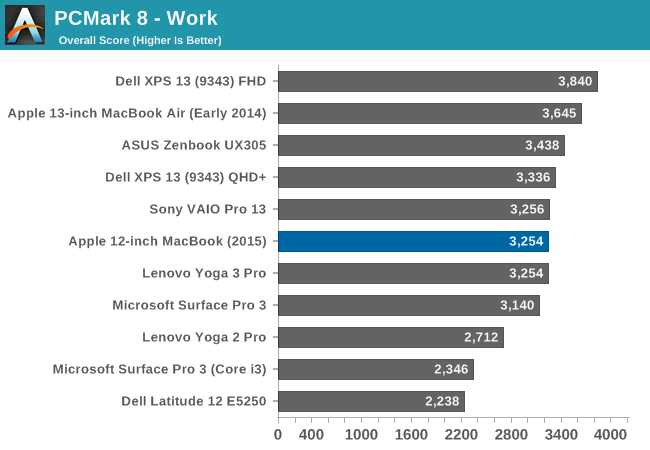
Depending on which sub-test we’re looking at, the PCMark workloads are a mix of bursty workloads, lightly threaded workloads, and heavily threaded workloads. As a result the MacBook and its Core M processor are given some opportunity to show off, and at other times is pushed back due to its cap on sustained performance.
The Home workload is one such light test, which plays into the MacBook’s favor. Here it’s towards the top of the charts, surpassing everything other than the Core M based Asus UX305, and then the more powerful Broadwell-U based Dell XPS 13s. I keep rattling on about workload types and this is a good example of why it matters, because in a light workload the MacBook is among the fastest of the ultra-portables, beating out many other Core M devices and also some Haswell based Ultrabooks. Put another way, in a light workload Core M can already deliver (and at times exceed) one-generation old Haswell Ultrabooks.
As for the Creative and Work workloads, the MacBook still places relatively well. Doing this well on the Creative workload was a bit of a surprise, since it’s the most demanding benchmark of the 3. I suspect we may be seeing a mix of dividends from the SSD and Core M’s GPU, Otherwise the lighter Work test actually has the MacBook farther behind the pack, with performance in-line with other Core M laptops, though not as exciting compared to the Ultrabooks.
Overall, between our OS X and Windows CPU benchmarks, what we’re finding is that the performance of the MacBook generally mirrors our expectations given what we know about its design and component selection. Given a light workload that allows the Core M CPU inside of the MacBook to turbo to its fastest speeds, it’s a very potent competitor in a small package, able to give all but the most recent Ultrabooks a run for their money. However heavier, sustained workloads drive a wider gap in between the two classes of devices, and in those cases the MacBook offers performance closer to Ultrabooks a 3-4 years old.
Shifting gears one more time, let’s take a look at GPU performance. GPU workloads present an interesting scenario for Core M, and by extension the MacBook. The underlying Intel HD Graphics 5300 GPU is a GT2 configuration, making it moderately powerful for an iGPU, however the power and thermal constrains on the MacBook means that the laptop doesn’t have the power required to run a GT2 GPU at full speed.
With the Broadwell CPU cores alone able to chew up 4.5W and then-some, a combined GPU+CPU workload will generally put the MacBook in a pinch. Consequently I don’t see the MacBook being used as any kind of gaming machine – the MacBook Air is undoubtedly a much stronger contender – but it’s useful to put this performance in context.
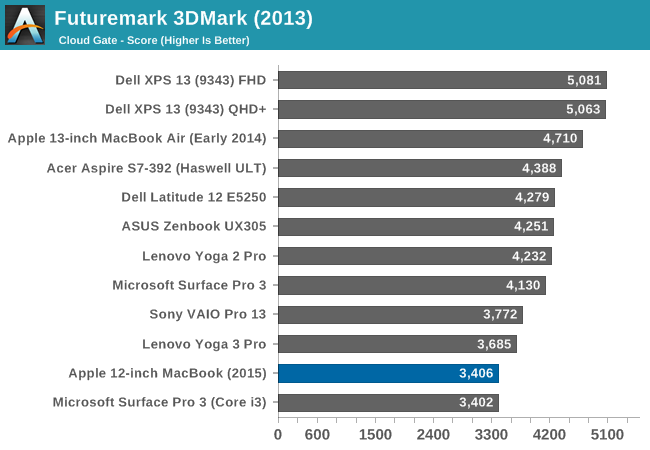
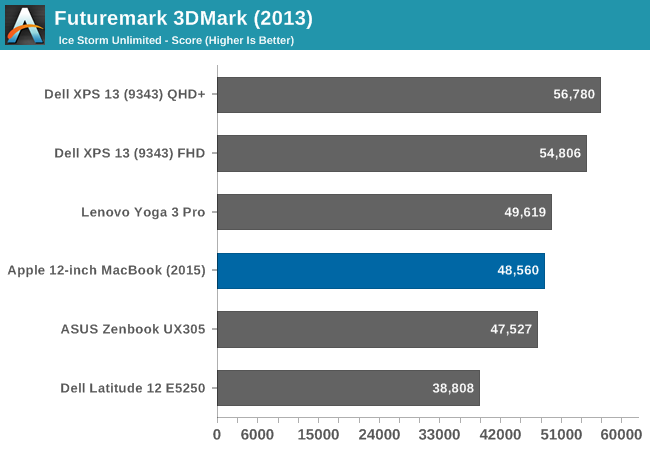
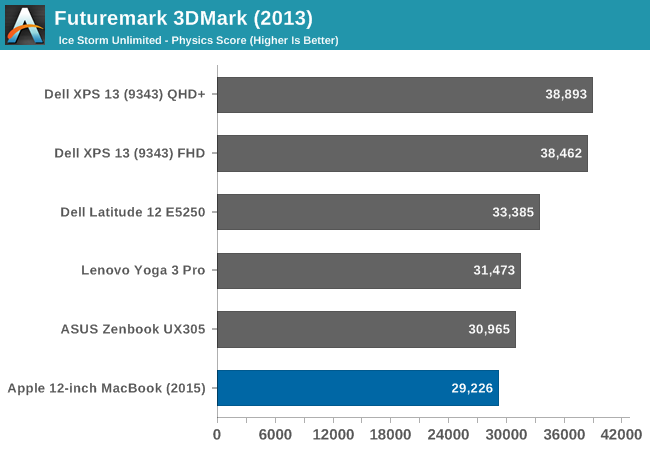
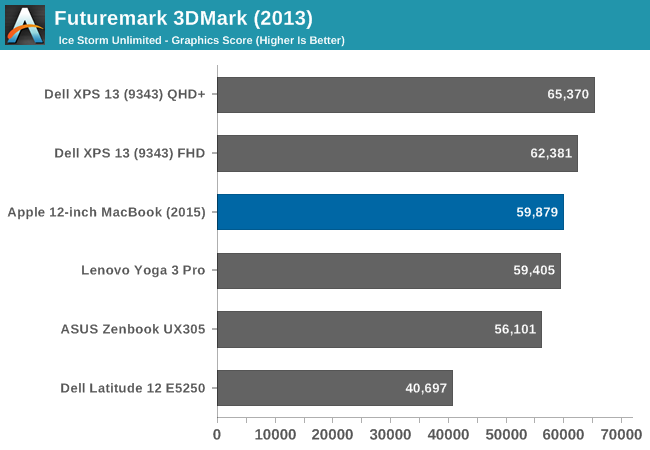
Our 3DMark scores handily illustrate this exact point. Facing significant power and thermal limits, the MacBook has to pull back in performance and consequently ends up near the bottom of our charts, versus its much better showing in PCMark. The 2014 MacBook Air 13” is some 38% faster at Cloud Gate, and on the newer Ice Storm benchmark the results aren’t much better. Of the two it’s worth noting that Cloud Gate is a much more complex and longer running benchmark, whereas Ice Storm is a quick running tablet-sized benchmark. Consequently Cloud Gate throttles harder and sooner, which is why the MacBook does relatively worse there. Overall the MacBook doesn’t even beat any of the other Core M laptops, which is a bit surprising. But nothing here is quite like the MacBook, so it’s somewhat different in its combination of small size and aluminum chassis.
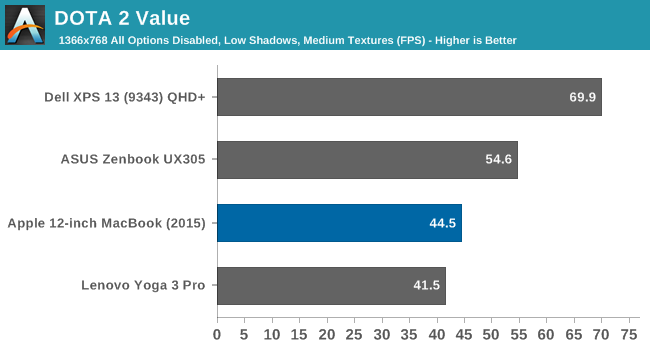
Meanwhile I have also run our DOTA 2 Value benchmark against our other Core M devices and the Broadwell-U based Dell XPS 13 for good measure. On an absolute basis 44.5fps is definitely playable for a game like DOTA, however on a relative basis this is a weaker showing than the UX305, not to mention the XPS 13. Compared to the UX305 the MacBook again appears to be throttling sooner and harder, whereas the Ultrabook-sized XPS takes full advantage of its higher power limits and better cooling.
Ultimately as we said when opening up our look at GPU performance, the MacBook’s GPU is potent on paper, but it simply doesn’t have the power and cooling capabilities needed to take full advantage of it. This means that while CPU performance isn’t too far removed from the Ultrabooks, GPU performance absolutely is.
Finally, I wanted to take one last look at performance relative to the tablets, this time from a GPU perspective.
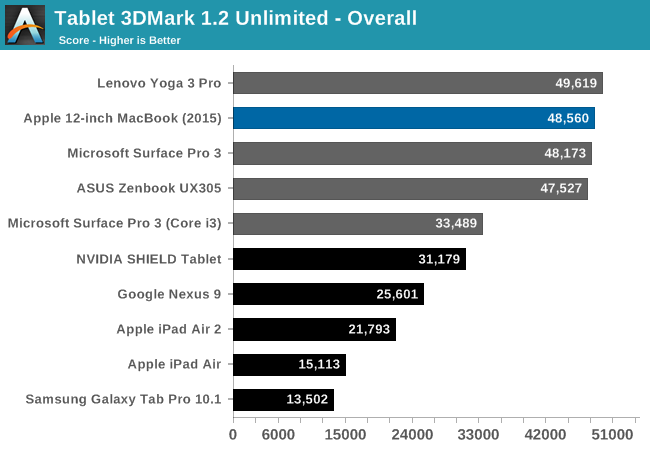
While the iPad Air 2 makes a good run on the MacBook in the web benchmarks, it and the other tablets are even more power limited than the MacBook, and as a result their GPU performance is even more constrained. The MacBook still has a better than 2x lead on the iPad Air 2 in this GPU benchmark, so judging from this it will be some time yet until an iPad's GPU performance catches up with this MacBook's.










354 Comments
View All Comments
darkich - Wednesday, April 15, 2015 - link
Oh Anandtech, it is blatantly obvious that you do everything you can to twist reality in favor of your sponsor (Intel).So MacBook has a twice better GPU than iPad Air 2?
Why didn't you used a *graphics* category to explain that fact?
Why didn't you ran Manhattan or T Rex and showed the respective scores?
iLovefloss - Wednesday, April 15, 2015 - link
They linked to a more comprehensive Core M review in the article. If you actually read the damn thing rather than trying to accuse people of being sellouts, then you maybe you'd caught that.Shit, the only thing more annoying than a social media (anti-)SJ conversation is tech websites review comments. Everybody is a sellout.
narcaz - Wednesday, April 15, 2015 - link
I am sorry, but i think this one of the of the more mediocre reviews from Anandtech:"Compared to the 128GB SSD and 4GB of RAM in the base MacBook Airs, this is the first ultra-portable Mac in a while where I can say even the base model feels properly equipped. At the very least users shouldn’t be struggling with RAM or SSD capacity for some time. Meanwhile given the fact that the equivalent upgrade of an 11” MacBook air would be $300 – bringing the total price to $1199 – this means that while the MacBook is still more expensive than a MacBook Air, the difference isn’t nearly as wide as it would first seem."
Copy paste from Apple's marketing? The difference is as wide as it would first seem when you look at the trade-off. Compared to the MBA you get better portability and a retina screen. But you loose connectivity, battery life, hd camera, magsafe, cpu/gpu performance. And according to your defined target audience (second device buyers) buying these upgrades doesn't make much sense. It is ok that the 12'' MB is expensive, but don't try to argue around this fact.
"As far as desktop performance goes, we haven’t found any major problems for the MacBook’s Intel HD Graphics 5300 GPU. Even with Core M’s power limits it doesn’t show any issues holding 60fps at the default virtual resolution of 1280 x 800, though I would not suggest going any higher unless it’s necessary."
I had the impression that higher resolutions don't work very well on the 12'' MB models in the Apple store. It felt like the first 13'' rMBP: more screen space, but a bit laggy. The performance of the HD 4000 wasn't good enough and took another hit with Yosemite (especially when connected to a second display). I am not willing to invest in a MB, which isn't future proof for at least 2-3 years. The same is true for the potential lack of 4K/60hz. I hoped for more depth in this area.
The review could have been more critical about the 1 USB C Port. If it breaks you can't even charge your machine anymore and out of warranty services are extremely expensive. But i think the comments discussed this point to death. Thanks for the extra remarks about the sustained performance in the comments and please put this in the review and maybe do more tests.
wave84 - Wednesday, April 15, 2015 - link
I don't really think the Macbook is expensive. This is actually useable as a main computer for a lot of users (journalists, web designers, web programmers, etc). It will do just fine, as long as you have 8GB RAM and 256 for storage, which you get.You lose some stuff indeed, but for 100 bucks you get retina screen, extreme portability, and most important of all, it's fanless and completely silent. This is a huge quality of life improvement which no review will take into account.
Also, i do not believe the port to be an issue. Either you are docked, so you have plenty of ports (and you only unplug one cable), either you are mobile, when one port is enough for 99% of use cases.
I am very close to buying it. Still waiting for some upgraded CPU numbers.
narcaz - Wednesday, April 15, 2015 - link
I am looking for a second device besides my 15'' rMBP. The iPad doesn't cut it anymore. But 1279$ + 79$ (needed for occasional presentation) is expensive compared to the 11'' MBA 899$+29$. Impossible to sugarcoat it. It looks like Apple's upselling strategy got you on the hook. You can rationalize this purchase as much as you want, but i don't want to pay for upgrades, which i don't need. If you value portability and retina screen fine, enjoy it, but this doesn't make it a very good deal.Even in the Apple ecosystem the single port is problematic. Airplay Screen Mirroring suffers from lags, iCloud Photo Library is cumbersome and there is no backup solution while being on the road. Cables aren't dead. I think the next version will have second port.
telsin - Wednesday, April 15, 2015 - link
I'm curious to see if a newer hardware revision of the Apple TV that they're likely to announce at WWDC resolves some of the airplay lag. That thing is still using an A5 processor, whereas the latest iphones are up to A8 (huge difference in CPU/GPU performance). I too found airplay rather obnoxious when I tried it. In OSX, you can have it treat an airplay target as a second monitor, but it really kind of sucks unless you're just putting something there to read as a static document.bogda - Wednesday, April 15, 2015 - link
Now, make MacBook Air with the same quality screen, smaller bezel (like on this MacBook) and keyboard that stretches from edge to edge (like on this MacBook) and I might actually switch from PC to Mac.Mushin - Wednesday, April 15, 2015 - link
As for the SSD which is only connected through PCIe 2.0 that is a limitation of Core M see:http://ark.intel.com/products/84666/Intel-Core-M-5...
cknobman - Wednesday, April 15, 2015 - link
All I can say is ehh.Sure its built nice and a super small form factor
BUT
Price is high, performance is just OK, and battery life is frankly underwhelming. Sure the battery life is not terrible but given the hype over the Core M I was expecting better battery life.
Still no touch screen and it is still confined to the limitations of a laptop.
The benefit of small underpowered devices like this should lie in their ability to serve multiple purposes easily and change form factors.
If I still have to use it like a laptop (IE: open it up, type on a keyboard) and pay such a high price then I may as well go get a laptop with more power and better battery life.
For this price I'd still rather have something like a Surface Pro 3. With its ability to serve multiple purposes I can use it like a tablet or a laptop, get better battery life, and get a touch screen. All while paying less.
nerd1 - Wednesday, April 15, 2015 - link
Sp3 is lighter, thinner, more powerful, has more ports, has more input methods and even cheaper.